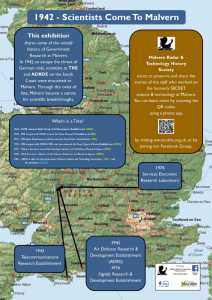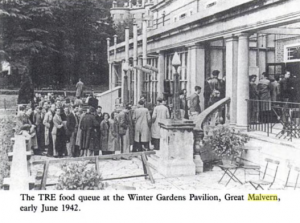Exodus to Malvern
Then came the bombshell, unheralded by rumour. There were, we are told, seventeen train loads of German parachute troops on the other side of the English Channel preparing to attack T.R.E. Worth Matravers.
The Bruneval Raid, a commando raid code named ‘Operating Biting’, to capture German radar equipment..
Exodus to Malvern
In early 1942, after the Americans had come to our aid, there was need to acquire a knowledge of a new German RADAR station installed at Bruneval , France, named Wurzburg. On the night of 27th March, a commando force raided the station and stole as much equipment as possible to ascertain the operational nature of this new RADAR dish. A Worth Scientific Officer D.H. Priest played a part in the Bruneval Raid, a commando raid code named ‘Operating Biting’, to capture German radar equipment.
He was on a launch with the naval party to help identify what equipment to bring back 41.
It became clear that there was a risk of a similar raid on our Research Establishments and German intelligence collection of our radar signals could reveal information about the function and performance of our experimental equipment. According to Spencer Freeman, after the raid there was evidence that a German Para troop unit had moved up somewhere behind Cherbourg and it was possible that they might have an intention of an attack on Swanage. A heavy scale bombing and parachute raid on the main units of the radar research establishment at Swanage. Finally, the situation became intolerable and in April 1942, the Chiefs of Staff committee directed the removal of both units (the TRE and the Air Defence Research and Development Establishment [ADRDE] from Christchurch) before the next full moon to Malvern College 40. There were personnel already stationed there since early 1939, by the the Ministry of Home Security. They developed a plan, “to evacuate the critical functions of government out of London” if a threat of air raids developed. A site was purchased in Malvern for the Ministry itself. Although it was never developed. The Air Ministry acquired jurisdiction, and used the site for a Signals Training Establishment, housed in prefabricated one storey buildings. In May, 1942, the Radar Research and Development Establishment (RRDE) was set up on the site, to develop truck mounted early warning radars.
On Monday 25th May the staff from Leeson House had finished loading 100’s of crates of various sizes ranging from a tea chest to an aero-engine crate onto a fleet of Pickford Removals vans. In the case of the 10 Centimetre group, they were allocated six vans. In the early morning of Tuesday 26th they left for Malvern, temporarily leaving their families in Swanage, they arrived at 1700 hrs. There they found hundreds of Pickford vans, Cranes, packing straw, mud, and people everywhere. The billeting office was unapproachable so they walked to the science block assigned to the group 40. The total number from the whole of TRE, at the peak of the move, was on one day a convoy of ninety vans all destined to Malvern College. The entire relocation took 14 days to complete39.
When the Swanage locals heard the rumour that a move was underway they enquired to where, but due to the secrecy, some staff replied Prangmere.
3rd May 1942 A.P. Rowe’s Diary Entry
In the late May 1942, the Superintendent of TRE Worth, A.P. Rowe wrote:
…In Swanage there were no great living and housing problems. Then came the bombshell, unheralded by rumour. There were, we are told, seventeen train loads of German parachute troops on the other side of the English Channel preparing to attack T.R.E.
The Prime Minister, we were told, had said that we must move away from the south coast before the next full moon. A whole regiment of infantry arrived to protect us; they blocked the road approaches to our key points, they encircled us with barb wire, they made preparations to put demolition charges in our more secret equipments and in the execution of their lawful duties, they made our lives a misery. Nor was this all.
Our Home Guard, of considerable strength, was expected to be on duty all night and work all day. My own time was spent less in dealing with the work at TRE than in discussions on whether we should die to the last scientist or run and if the latter, where… 31.
Malvern Winter Gardens
The requisitioned Winter Gardens Pavilion was an ill equipped building to provide three full meals a day to a thousand people.
It had a spacious interior filled to capacity with army type barrack tables and forms. Kitchens were set up in the area beyond the stage.
In the first instance it was staffed with WAAF’s who did not take kindly to feeding civilians. The locals would peer at the scientists through the windows, making them feel like animals in a zoo. It had a numerous canteen managers, one of them sold off the best meat on the black market. On the occasion the TRE personnel had been making jokes about eating horse meat- they probably were! 40

